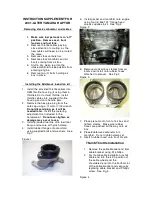
Useful information
i
This Owner's Manual describes all mod-
els, series and optional equipment for your
vehicle that were available at the time of
going to press. Country-specific differen-
ces are possible. Note that your vehicle
may not be fitted with all features descri-
bed. This is also the case for systems and
functions relevant to safety.
i
Read the information on qualified special-
Loading guidelines
G
WARNING
If objects, luggage or loads are not secured or
not secured sufficiently, they could slip, tip
over or be flung around and thereby hit vehicle
occupants. There is a risk of injury, especially
when braking or abruptly changing directions.
Always store objects so that they cannot be
flung around. Secure objects, luggage or
loads against slipping or tipping before the
journey.
G
WARNING
If you load the vehicle unevenly, driving char-
acteristics such as steering and braking
behaviour may be severely impaired. There is
a risk of an accident.
Load the vehicle evenly. Secure the load so
that it cannot slip.
G
WARNING
Combustion engines emit poisonous exhaust
gases such as carbon monoxide. If the tail-
gate/rear door is open when the engine is
running, particularly if the vehicle is moving,
exhaust fumes could enter the passenger
compartment. There is a risk of poisoning.
Turn off the engine before opening the tail-
gate/rear door. Never drive off with the tail-
gate/rear door open.
!
The non-slip mats cannot be used for
securing loads and must be replaced
should the following become apparent:
R
signs of deformation or development of
squashed areas
R
traces of cracking
R
cutting
After an accident, have the following checked
at a specialist workshop:
R
damaged load compartment floor
R
damaged load surface
R
lashing eyelets
R
lashing material
Otherwise, when you next transport a load, it
may not be sufficiently secured.
Load distribution (example: station wagon)
Driving, braking and steering characteristics
change depending on:
R
type of load
R
weight
R
the centre of gravity of the load
You should therefore load your vehicle as
shown in the illustrations.
Observe the following notes when transport-
ing a load:
R
when transporting a load, never exceed the
maximum permissible gross vehicle weight
or the permissible axle loads for the vehicle
(including occupants).
R
position heavy loads as far forwards as pos-
sible and as low down in the luggage com-
partment as possible.
128
Loading guidelines
Stowing and features
Summary of Contents for G-Class
Page 1: ...G Class Owner s Manual Nur f r internen Gebrauch For internal use only...
Page 4: ......
Page 19: ...Cockpit 18 Instrument cluster 19 Centre console 21 17 At a glance...
Page 50: ...48...
Page 58: ...56...
Page 78: ...76...
Page 86: ...84...
Page 128: ...126...
Page 141: ...Useful information 140 Engine compartment 140 Service 145 Care 147 139 Maintenance and care...
Page 154: ...152...
Page 174: ...172...
Page 188: ...186...
Page 205: ...203...
Page 206: ...204...
















































